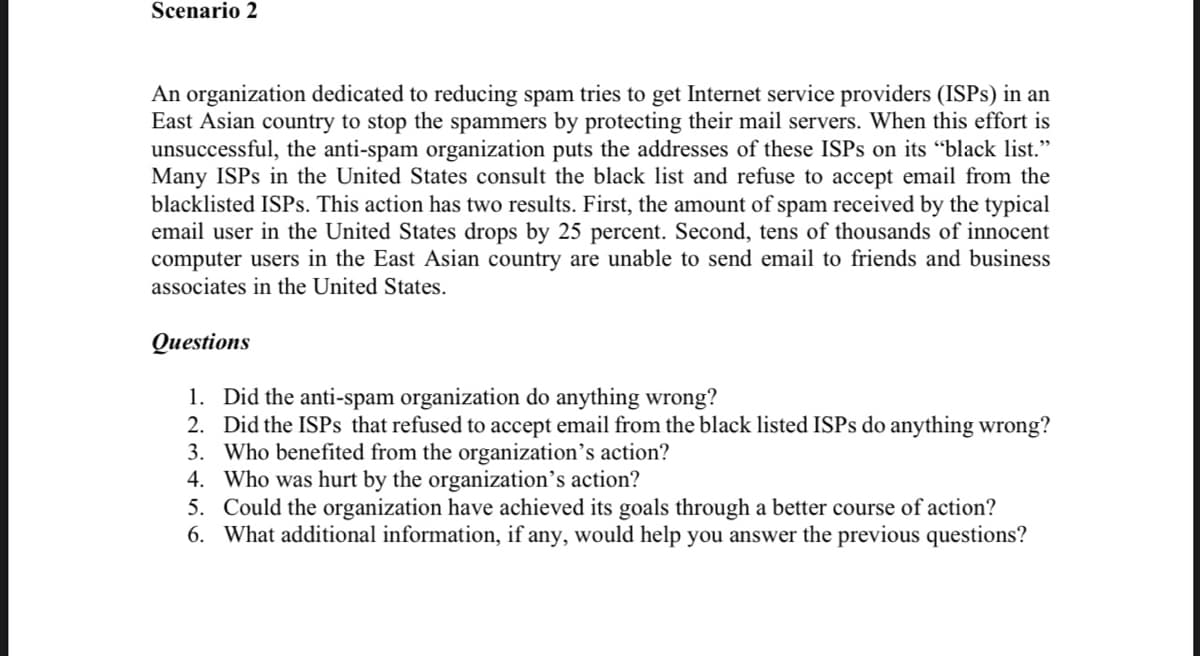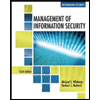An organization dedicated to reducing spam tries to get Internet service providers (ISPS) in an East Asian country to stop the spammers by protecting their mail servers. When this effort is unsuccessful, the anti-spam organization puts the addresses of these ISPS on its "black list." Many ISPS in the United States consult the black list and refuse to accept email from the blacklisted ISPS. This action has two results. First, the amount of spam received by the typical email user in the United States drops by 25 percent. Second, tens of thousands of innocent computer users in the East Asian country are unable to send email to friends and business associates in the United States. Questions 1. Did the anti-spam organization do anything wrong? 2. Did the ISPS that refused to accept email from the black listed ISPS do anything wrong? 3. Who benefited from the organization's action? 4. Who was hurt by the organization's action? 5. Could the organization have achieved its goals through a better course of action? 6. What additional information, if any, would help you answer the previous questions?
An organization dedicated to reducing spam tries to get Internet service providers (ISPS) in an East Asian country to stop the spammers by protecting their mail servers. When this effort is unsuccessful, the anti-spam organization puts the addresses of these ISPS on its "black list." Many ISPS in the United States consult the black list and refuse to accept email from the blacklisted ISPS. This action has two results. First, the amount of spam received by the typical email user in the United States drops by 25 percent. Second, tens of thousands of innocent computer users in the East Asian country are unable to send email to friends and business associates in the United States. Questions 1. Did the anti-spam organization do anything wrong? 2. Did the ISPS that refused to accept email from the black listed ISPS do anything wrong? 3. Who benefited from the organization's action? 4. Who was hurt by the organization's action? 5. Could the organization have achieved its goals through a better course of action? 6. What additional information, if any, would help you answer the previous questions?
Management Of Information Security
6th Edition
ISBN:9781337405713
Author:WHITMAN, Michael.
Publisher:WHITMAN, Michael.
Chapter2: Compliance: Law And Ethics
Section: Chapter Questions
Problem 1EDM
Related questions
Question
100%

Transcribed Image Text:Scenario 2
An organization dedicated to reducing spam tries to get Internet service providers (ISPS) in an
East Asian country to stop the spammers by protecting their mail servers. When this effort is
unsuccessful, the anti-spam organization puts the addresses of these ISPS on its "black list."
Many ISPS in the United States consult the black list and refuse to accept email from the
blacklisted ISPS. This action has two results. First, the amount of spam received by the typical
email user in the United States drops by 25 percent. Second, tens of thousands of innocent
computer users in the East Asian country are unable to send email to friends and business
associates in the United States.
Questions
1. Did the anti-spam organization do anything wrong?
2. Did the ISPS that refused to accept email from the black listed ISPS do anything wrong?
3. Who benefited from the organization's action?
4. Who was hurt by the organization's action?
5. Could the organization have achieved its goals through a better course of action?
6. What additional information, if any, would help you answer the previous questions?
Expert Solution
This question has been solved!
Explore an expertly crafted, step-by-step solution for a thorough understanding of key concepts.
This is a popular solution!
Trending now
This is a popular solution!
Step by step
Solved in 2 steps with 6 images

Knowledge Booster
Learn more about
Need a deep-dive on the concept behind this application? Look no further. Learn more about this topic, computer-science and related others by exploring similar questions and additional content below.Recommended textbooks for you

Management Of Information Security
Computer Science
ISBN:
9781337405713
Author:
WHITMAN, Michael.
Publisher:
Cengage Learning,

Management Of Information Security
Computer Science
ISBN:
9781337405713
Author:
WHITMAN, Michael.
Publisher:
Cengage Learning,